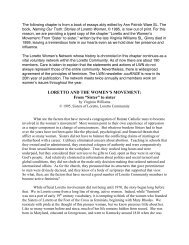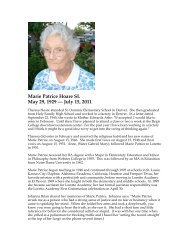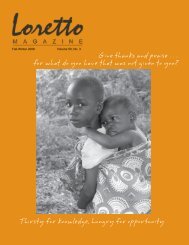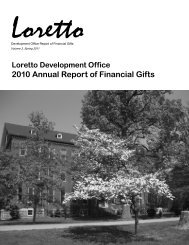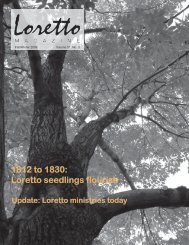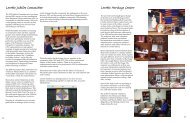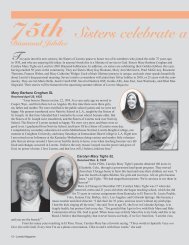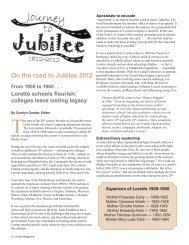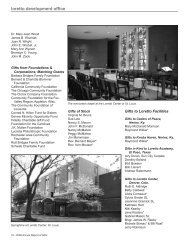Loretto Magazine, Fall-Winter 2010, part 1 - Loretto Community
Loretto Magazine, Fall-Winter 2010, part 1 - Loretto Community
Loretto Magazine, Fall-Winter 2010, part 1 - Loretto Community
Create successful ePaper yourself
Turn your PDF publications into a flip-book with our unique Google optimized e-Paper software.
Marian McAvoy SL“The 1960s brought changes to the church, certainly,as well as to <strong>Loretto</strong>. My own life is an example. Thedecade saw me move from a high school Englishteacher wearing a habit to a religious educator incontemporary garb teaching Catholic adults about thetheological basis for the Vatican Council and preparingthem to take on roles as decision makers on parishcouncils. A new master’s degree in pastoral theologyhad prepared me for this work.As a delegate to <strong>Loretto</strong>’s Special Chapter in thelate ’60s, I celebrated as that body accepted a newgovernment structure for the community based onshared <strong>part</strong>icipation in decision-making, both on thepersonal and the communal level. The respect for eachperson and his or her capacity to make decisions asadults was a <strong>part</strong> of two key principles of the Council’sdeliberations: subsidiarity and collegiality. They are, I’mglad to report, still operative within <strong>Loretto</strong>.Denise Ann Clifford SL“The years after Vatican II were exhilarating times inthe church. I was involved in parochial school educationwhen the changes of Vatican II began to filter downthrough ecclesial levels to the parishes. The leadershipin <strong>Loretto</strong> had already initiated a major study of ourrule and customs, and had implemented changes incommunity life and religious attire.Before Vatican II, we were respected as “the nuns” whotaught the children in the parish school and religiouseducation program. As the spirit of Vatican II unfolded,we were recognized leaders and teachers in the processof creating a new image of church as the “people ofGod.” We were . . .. . . nominated and elected to newly formed parishcouncils and committees;. . . selected for new liturgical roles: ministers of theEucharist, lectors, cantors;. . . instructors in adult education classes in scripture,theology, and parenting classes especially in regard tothe sacraments of Initiation, Baptism, and Eucharist;. . . members of study groups exploring andrecommending how to implement the directives ofVatican II in our individual parishes; and. . . creating and renewing communities dedicated tothe work of the Gospel.was so concerned about making the liturgical movement a <strong>part</strong> ofVatican II.He was on the committee and he did it. He did a lot of thingsbesides turning the altar around and establishing the vernacular asthe language of worship.The Council ended by the first of the year of 1966. So inDecember of 1965 there was a great outdoor finale. I rememberthe bishops were sitting in long lines in front of St. Peter’s, and ifyou’ve been there you know how big it is. Up at the front, right infront of the door, was seated the pope, who by this time was PaulVI. He was seated facing out, and all the bishops were in rows.Again, this is colorful drama, very rich in its presentation, withthe marvelous Gregorian chant singers.I must give you something of the setting. The picture that Iwant to describe is enormously colorful. Those bishops in theirrobes of purple, and then the white, and then the gold, and thenSt. Peter’s, and then all the lights on, all the candles lighted— it was a great celebration, a great time. It was a great visualrepresentation of a church bringing itself together.The program at the end of the Mass was to honor certain peoplein the church. They brought people out in fours, and the first werefour artists. They came out and made a little bow to the pope andwent up and received from him a little scroll. Then they went offand four historians came forward, then four musicians. Finallyfour women, and they bowed and went up and got their littlescrolls.I turned to Godfrey Diekmann, who was sitting next to me, and Isaid, “Godfrey, that’s all wrong.”“Wrong, Sister? What’s the matter with it? They should honorthese people for what they’ve done for the church.” I said, “I’lltell you what’s wrong, Godfrey. Women are not a category in thechurch!” He looked at me and he said to me, “Sister, you’re right.But we don’t see it, we don’t understand it, and you’re going tohave to explain it to us.”I thought that was a pretty big man who said that to me, and soevery time thereafter he mentioned it in print, I wanted to thankhim an extra time because he has lived up to this vision in someof his own writings.No, women are not a category in the church. The church itselfis men and women. Men and women attempting to live out theGospel and to listen to the words of Jesus and to form that kind ofa body of people who have heard those words and who are tryingto live them out together in the church. It’s not the edifice; it’s notSt. Peter’s; it’s not any gathering of associations. It’s the men andwomen who form the church.I look back on Vatican II with great affection,not only because the changes were much in linewith what I would have wanted anyway, but alsobecause it gave me the insight that the church canchange.12 • <strong>Loretto</strong> <strong>Magazine</strong>



